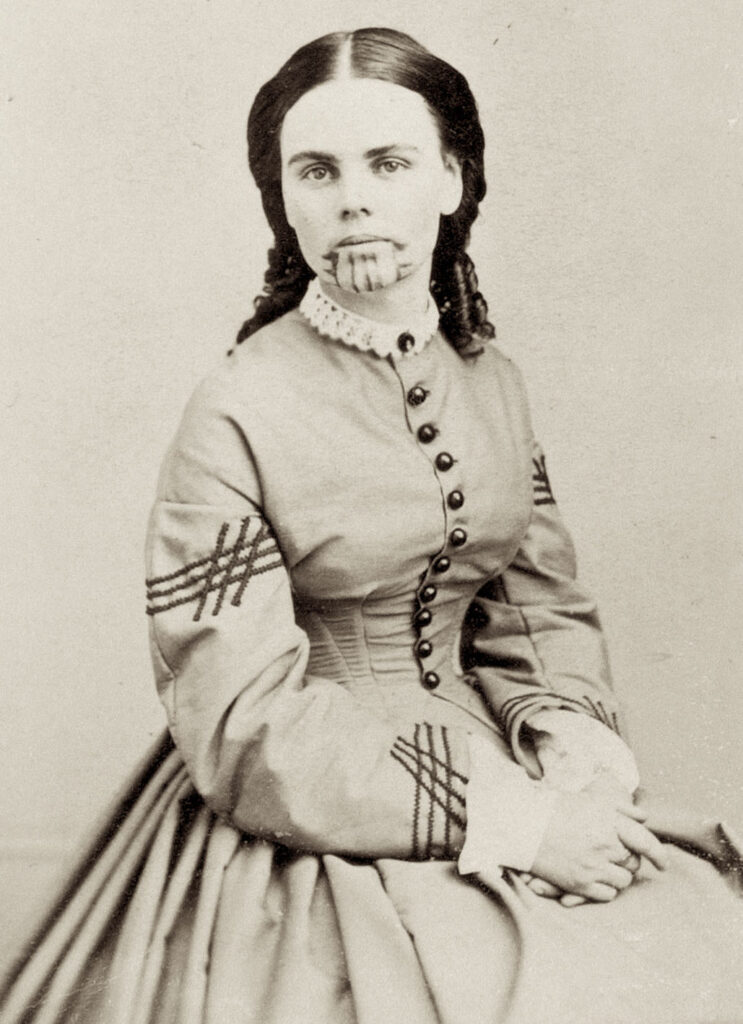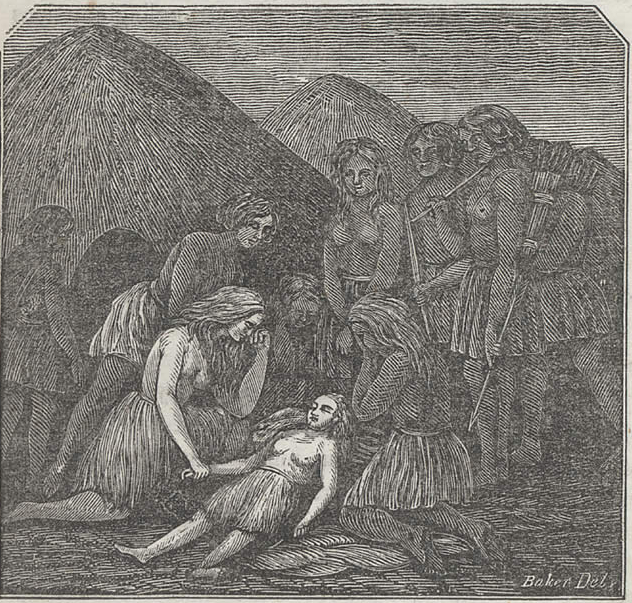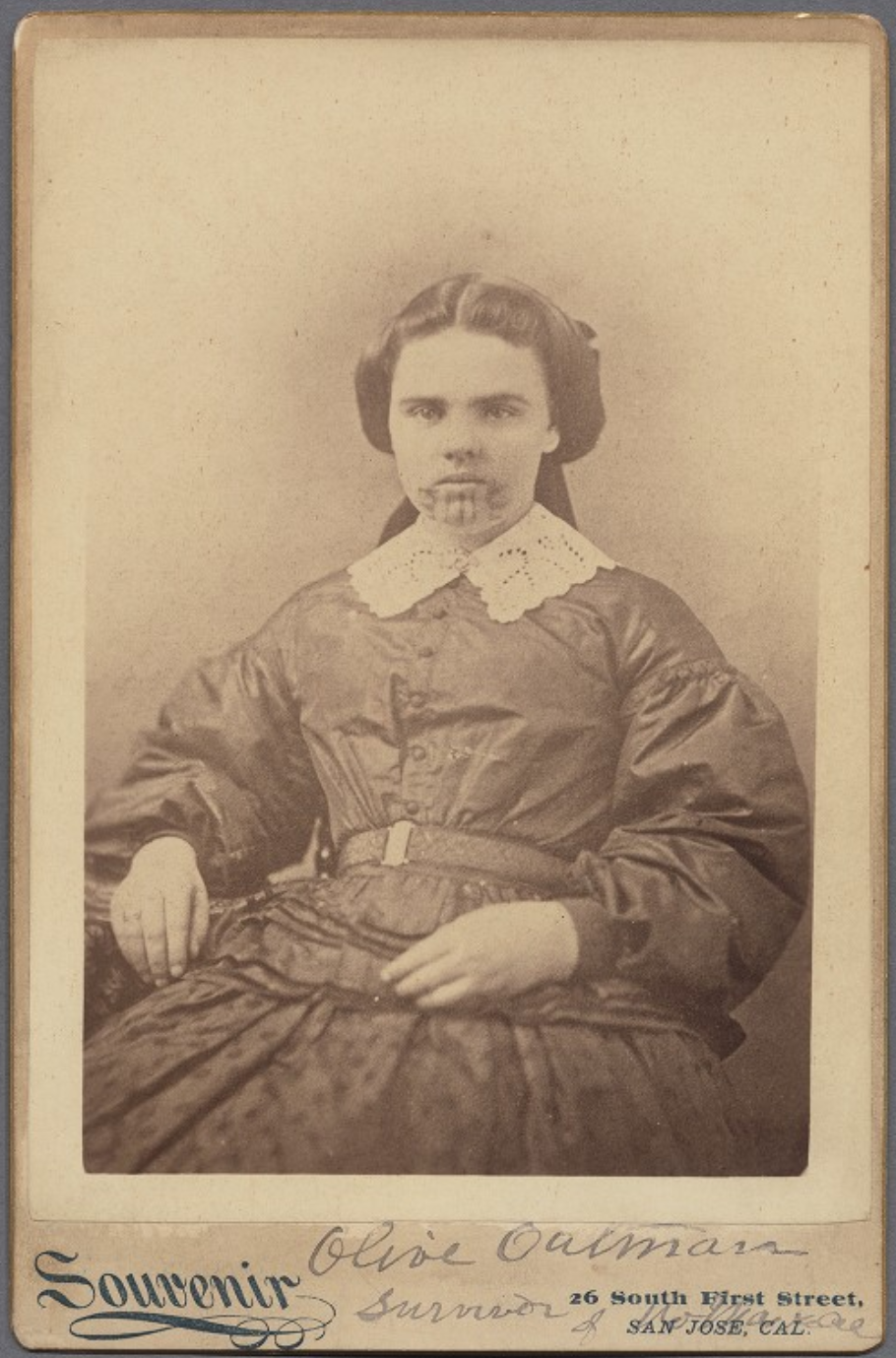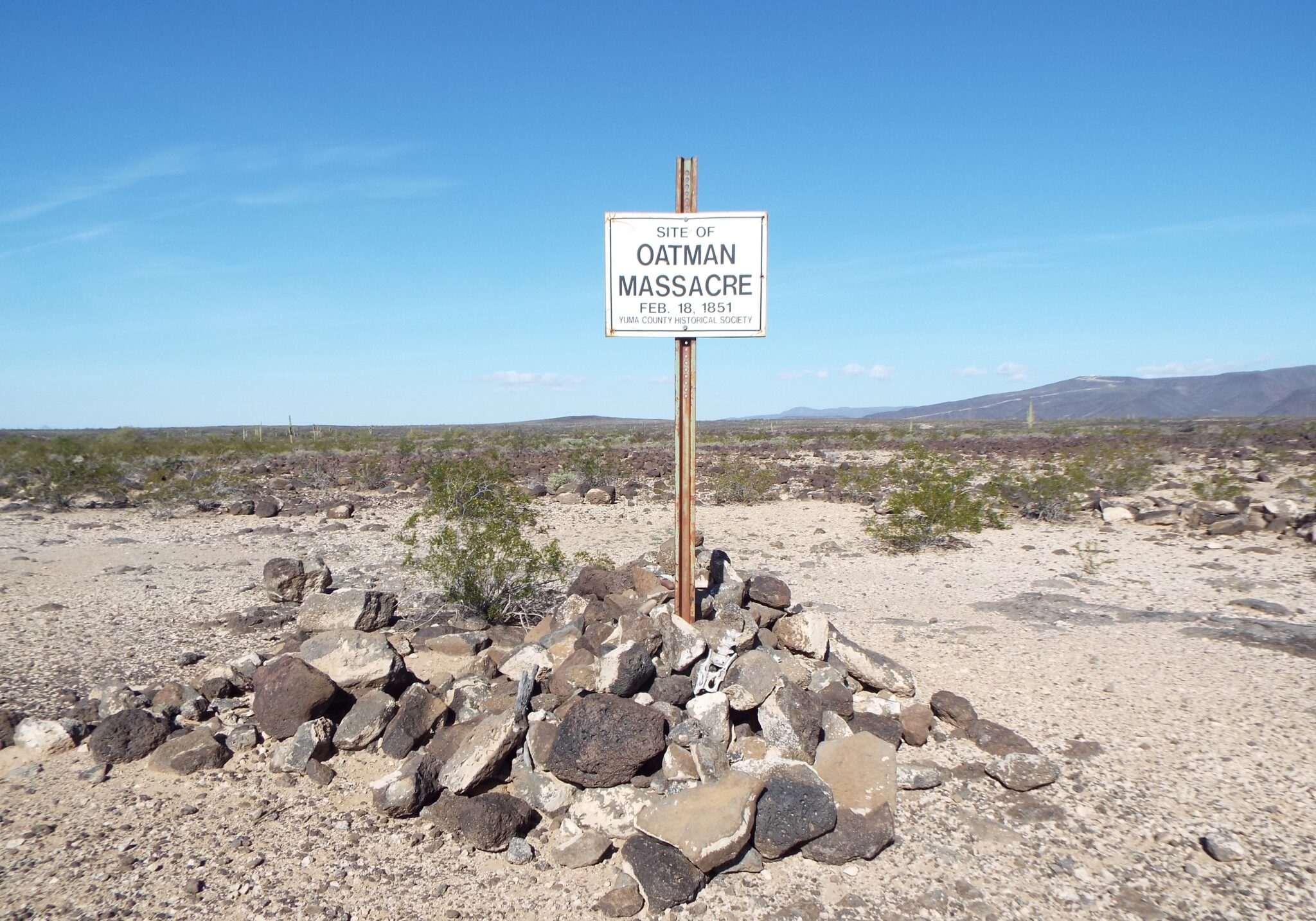Even those who aren’t familiar with the name “Olive Oatman” are undoubtedly familiar with her photo. The young, dark-haired girl with the solemn expression and distinctive chin tattoo has become synonymous with the hardships faced by the pioneers who set out as a part of America’s Westward Expansion, a mass migration that helped shape the middle of the 19th century.
Even as thousands of intrepid settlers made their way across the Midwestern plains on the Oregon Trail, groups of Mormon pilgrims headed to another destination: Salt Lake City. And still others headed deep into the southwestern deserts for reasons that were entirely their own — and that is where the Oatman family was going when they were waylaid at the place now memorialized with a single, plain sign that reminds travellers what happened there: the Oatman Massacre.
The teenage Olive survived the attack that killed most of her family, and experienced a life that few lived to tell of. She’s most famous for her time spent among the Native American tribes of the American southwest, but her story begins much earlier than that: with visions, prophecy, and religious fervor.

The road to Hell is paved with good intentions
Emigrants who packed up everything and left the relative comfort of the East Coast for the wild landscape of the West did so for all kinds of reasons. Some looked for new opportunities, some were just out for adventure, and some, well, it wasn’t so much about where they were going but what they wanted to leave behind. For the Oatman family, their foray into the Western frontier began with the revelations of a prophet.
Roys Oatman and his wife, Mary Ann, had seven children between 1834 and 1849. It was also during those years that the Methodist family converted to Mormonism, after being inspired by the prophecies and texts revealed by Joseph Smith.
For those not familiar with the foundations of Mormonism, it’s worth a quick aside to understand just why the Oatman family would leave the relative safety of Vermont and head west. Smith claimed to have found a set of golden plates that he was able to translate with the help of an angel. He preached that it was their duty to seek out the City of Zion, and along the way, they met with a lot of resistance. Believers were tarred and feathered, run out of town, and persecuted for their beliefs. And there were a lot of believers — including Roys and his family.

In 1844, Smith announced he was going to run for the presidency; however, not all those who considered themselves Mormon agreed with the move, or all of his teachings, for that matter. One of the most controversial was polygamy, and it was enough to splinter his followers into other groups. After Smith destroyed a press run by one of these rival factions, he called on the local militia for help. He was arrested, jailed, and on June 27, a mob broke into the jail and killed him.
One of the rival factions that had been such a thorn in Smith’s side was headed by a boy named James Colin Brewster. Brewster had been only 10 years old when rumors of his gift of prophecy began to circulate, and at first, the mainstream Mormon elders believed he was a genuine seer. Buoyed by this, Brewster started bringing the revelations fast and furious, ultimately writing — with the help of his father — a text he called the book of Esdras. Included in the text was a description of the promised land. It was a land destined to be the gathering place of saints, and it was called Cedonia, the Land of Bashan. Brewster claimed that the land was in a remote corner of the country, somewhere in the southwest.
Smith and the mainstream church denounced Brewster as a fraud, and Brewster gathered his own following — appropriately, they were called the Brewsterites, and more formally, they were the Church of Christ.
The Oatman family were among Brewster’s followers, and at the time Smith was killed, the young would-be prophet was just 17 years old. But that, many decided, was old enough to lead the faithful to the promised land — even though he had been officially excommunicated from the Mormon church before Smith died. His prophecies began to get more specific, and he claimed their final destination was on the river “Amli”, which he claimed was another name for the Rio Grande.
So it came to pass that on August 5, 1850, the Oatman family left Missouri in a group of about 90 people. There were 17 different families in their little caravan, made up of 27 wagons, a few hundred cattle, and — as it would turn out — quite a bit of strife.
Just a few more names among the thousands of dead
Today, traveling across the country can be done in a day. AIrlines are uncomfortable and inconvenient and one of those modern luxuries no one really likes, but it’s almost an infinite improvement over the conditions in which the Oatman family — and thousands of other families — needed to try to survive on their trek westward.

One in ten people who set out just on the Oregon Trail didn’t survive. It was an active route for only 25 years, but it still has the dubious distinction of being America’s longest graveyard with around 65,000 graves scattered along the way — that’s one burial every 50 yards from Missouri to Oregon City.
There was no shortage of ways to die. Disease was rampant, and in some cases, a person who was perfectly healthy in the morning would be dead by dusk. There was cholera and scurvy, malaria, and of course, there was always the possibility of snakebites, falls, broken bones, infections, and accidental gunshot wounds — something that happened more often than you might expect. Just imagine the hardships: surviving on nothing more than the dried food you could carry and what you could hunt. Dust and dirt that infected every nook and cranny. And — if you were among the later settlers that set off — you were following in the footsteps of thousands of other people and animals… and trekking through all the waste they left in their wake.
It’s truly not surprising that tempers might be running wild, and that conflict within groups who needed to stay together for safety might be commonplace. Things only got worse for the Brewsterites as they left the plains and headed into the mountains of New Mexico, traveling a route known to the natives as Jornada Del Muerto, or the Journey of Death. It wasn’t just difficult terrain, either — it was one of the longest, hottest, and driest years on record, and those that lived there were getting desperate.
As the caravan of devout families traveled, they passed more and more ominous landmarks: human remains, picked clean by scavengers, dead and discarded pack animals, goods and garbage that oxen were no longer strong enough to carry. Native tribes tested, every night — the caravan would wake to find some of their animals gone, and fear was nearly tangible. Fear among those who had faith not quite as strong as Brewster’s, that is: even as workers on the US mail train warned them that it wasn’t safe, he insisted their faith would protect them from whatever dangers they might face.
So, you might be able to see why the Oatman family only traveled with the rest of the Brewerites as far as Las Vegas. That, historians say, is when the party split: 26 people, including the Oatmans and three other families, set off in the direction of California, while the others followed their prophet.
The splinter group headed along the El Camino Real, and in January of 1851, they made camp at La Joya. They worked for a bit cutting and delivering hay, before moving on toward Maricopa Wells. By this time, they knew they were being followed.
Cooler heads prevailed, at first, and the group decided to wait at the Pima villages until they were joined by travellers who were inevitably coming along behind them. Greater numbers would have made them a less tempting target, but again, it’s possible to see why they would just want to get on with their journey and reach their destination. After three weeks of waiting, Roys decided that he and his family — including his wife, who was due to give birth any day — were going to push on. They were going to be doing it alone, too, as no other families would join them. Their destination was Fort Yuma, 190 miles away. That doesn’t sound far, in our 21st century world of wide roads and fast cars, but the Oatman family would have been trundling along at a pace that was, at the fastest, between 15 and 20 miles per day.
A lot can happen in that kind of time, and things did happen. Horrible things.
The Oatmans decided to take a shortcut, but they were slowed down even more. Their oxen were ill-suited to the terrain they found themselves crossing, and they were struggling to get up and down the rocky hills and plateaus.
On February 18, 1851, they spotted a large group approaching. There were between 17 and 20 — members of a Native American tribe that have variously been called Apache, Yavapai, and Maricopa. The details of exactly how the confrontation happened are understandably scarce, but it’s believed Roys approached the group, who demanded tobacco and pipes. That, Roys shared, but when they demanded food, and were not satisfied with the bread he offered, he told them that he didn’t have enough to feed his own family, much less them. The conflict escalated, and by the time it was over, all but three were dead.
In her later memoirs, Olive Oatman described seeing the broken and bloody bodies of her family members, scattered across the ground. Then, she fell into unconsciousness. Olive and her younger sister, Mary Ann, weren’t killed — they were taken captive, and when they woke, they spent several days on a march to the village of their captors. Almost immediately, they were stripped of their shoes — making it almost impossible to walk on their bloody and bruised feet, much less try to run away.
Olive wrote of those first few days when the grief was fresh and they were still coming to terms with the fact that everything had changed in a heartbeat. She wrote of stopping to make camp, of watching a cooking fire built, saying:
“They boiled some of the beans just from our wagon, mixed some flour with water, and baked it in the ashes. They offered us some food, but in the most insulting and taunting manner, continually making merry over every indication of grief in us, and with which our hearts were ready to break. We could not eat.”
There was one more survivor: Lorenzo, who has an important part to play in his sisters’ story. He survived only by sheer luck, later describing waking “with the mangled remains of my own parents lying nearby, my scalp torn open, my person covered with blood, alone, friendless, in a wild, mountain, dismal, wilderness region, exposed to the ravenous beasts, and more, to the ferocity of more than brutal savages and human-shaped demons.”
Incredibly, he managed to make his way back to the Pima village and the safety they had left behind, joining up with another group heading to California. Along the way, he and the family who had taken him in stopped at the site of the massacre. The Oatmans were buried in a mass grave, and Lorenzo would embark on a quest to find his sisters — who were not among the dead.
From slave to treasure
Mary Ann barely survived the march to the village, carried part of the way by one of their captors when she grew so weak — and, Olive later said, so “utterly fearless of death” — that she could no longer walk.
Nevertheless, they made it to camp: the arrival of the raiding party was greeted with dancing, singing, and merry-making, and Olive’s description of life among them isn’t for the faint of heart. They described a village where women were “the laborers and principal burden-bearers,” and where she and her sister were immediately put to work as slaves; only the slightest excuse was needed for whippings and beatings to be handed out, but it was the foreboding sense that something much worse was waiting just around the next corner, just coming with the new dawn, that truly took a toll. Olive later wrote,
“There was no beauty, no loveliness, no attractions in the country possessed by these unlovely creatures […] Sometimes I would tell [Mary] that I saw but little chance for escape; that we had better be good and ready for any fate, and try to wait in submission for our lot.”
Months into their captivity, and Olive wrote that they became more “merciful,” in large part because of her sister, and in part because of their skill at learning their captors’ language. The women and children they met were particularly fascinated with the stories of their home, of the ocean, and of their travels. Among themselves, though, Olive described a spirit of “low obscenity and meanness,” and they would regularly ask the girls if they wanted to escape — a question they didn’t dare answer honestly.
Fortunately for the girls, a nearby group of Mohave had been trading with this group for several years. And finally, they came — only after, Olive said,
“Months rolled by, finding us early and late at our burden-bearing and torturing labors, plying hands and feet to heed the demands of our lazy lords, and the taunts and exactions of a swarm of heathen urchins, sometimes set over us.”
The Mohave emissary was made up of five men and one woman; her appearance gave the girls hope that if they were sold, they may find their lot in life even slightly improved. And they were sold — the Mohave paid for them in horses, blankets, and food. They were on the move again, and ten days later, they came to the Mohave village.

Marine 69-71 – Own work, CC BY-SA 4.0
Here, Olive wrote, they found a home. They were welcomed into the chief’s home and taken into the care of his wife. The woman who had negotiated for their purchase had been the chief’s daughter, and her sympathy toward their plight gave them the better life they hadn’t dared to dream of, much less speak of. While the sisters had been shocked at their captors’ lifestyle and their apparent inability to survive on anything that they hadn’t killed or stolen, their Mohave family even gave them their own plot of land to grow crops. They were expected to contribute to the tribe’s welfare, and they did: they gathered wood, dug for roots, planted and harvested crops, and foraged for berries.
They made friends, too. They were given nicknames, and the facial tattoo that would make Olive’s appearance so distinctive — and strange, in the eyes of the world she had been born into. It was done to both Mary and Olive, and it was a painful process. Their skin was pricked and a pigment made from the powder of river rocks and the juice from weeds was rubbed into their bloody skin. Painful, yes, but it was a mark of friendship and of respect. They were family.
And as a family, the Mohave did all they could when Mary Ann grew weaker and weaker. She died in 1855, after a long illness caused by a lack of nutrition. It wasn’t just Mary Ann, either — drought had made food scarce, and Olive later remembered traveling for days to find berries that would sustain the dying for just a little longer. She helped tend to the sick, administered medicine, and felt the devastation that came with failure. Then, she would travel for days again, searching for bird eggs, for roots, for anything that could prolong her sister’s life until the rivers were filled with fish again.
But for all her efforts, and the efforts of the chief and his family, Mary Ann passed away. “She sank into the sleep of death as quietly as sinks the innocent infant to sleep in its mother’s arms,” Olive would later remember. While tradition dictated that the bodies of the tribe’s dead were to be cremated, the chief’s wife appealed to her husband to allow Olive to do as she wished with her sister’s body, and she was ultimately buried according to her own traditions. Now, Olive was truly alone, save the continued kindness of the chief’s wife and daughter, which she said sustained her more than any bit of gruel or handful of corn.
The desperate search of a heartbroken brother
Years passed, and Lorenzo never gave up the search for his sisters. He joined expeditions of explorers and prospectors, he searched the length and breadth of southern California for even the slightest bit of information or indeed, of hope they were still alive. He even petitioned the governor of California for help, and got a response he hadn’t wanted: the governor had no authority to do anything.
Lorenzo’s determination kept the girls’ plight the talk of the towns. And that meant he wasn’t the only one looking for his sisters; in 1853, a man named Henry Grinnell passed through Fort Yuma and heard the tale of the two young girls who had been taken captive. Finding those who were lost was in his blood: he was the nephew of another Henry Grinnell, who used the profits from his shipping company to fund the voyages that went in search of Sir John Franklin, who went missing during his attempts to find the Northwest Passage.
Our Grinnell was a carpenter, but an inquisitive one. He asked so many questions for so long, that he was finally approached by a Native American man who had some information. His name was Francisco, and he asked Grinnell about the girls in January of 1856. Grinnell — who pretended to get his information directly from the newspaper he was holding — told Francisco that the American government knew there were two girls being held against their will somewhere in the southwest. He added that they were prepared to go to war to save them… unless that is, their captors saw fit to release them.
Francisco promised to bring the girls to safety, in exchange for a few blankets and some beads. He only asked for 20 days and promised he would return.
Even as Grinnell was ridiculed for his faith that the emissary would, indeed, do all he could to rescue the girls, Francisco really did head off to the Mohave tribe where Olive still lived. For her part, Olive knew that the attitudes of the chief and his wife seemed to change, and finally, she came to realize that someone was, indeed, trying to bargain for her release. The Mohave didn’t want to let her go, though, even going as far as to tell Francisco that this wasn’t the girl he was looking for. She wasn’t American, they insisted, she was from a faraway tribe that lived in the same direction as the setting sun. They told Olive to tell Francisco the same, but when it came time for her to talk, she told the truth.
She was threatened with torture, called a liar, told they were simply not going to let her go. But they did: a beautiful white horse was added to seal the deal, and Olive visited her sister’s grave one last time before she left for Fort Yuma.
Reacclimation wasn’t easy for Olive; she had transitioned almost completely from speaking English, and when she — accompanied by the chief’s daughter — returned to the fort, she was quickly given more “appropriate” clothing to wear. She was given over to the care of women working in the fort, and Lorenzo read about her return in the same paper Grinnell had pretended to read from. Confirming it was true, he headed back to Fort Yuma and they were quickly reunited. Here is about where Lorenzo’s part in the story ends. He traveled with his sister for a bit, living with her in California and New York. He eventually married and got into the hotel business, and died unexpectedly in 1901.
As for Olive, she struggled to readjust to the life she’d been taken from. She kept her promise to the Mohave: whenever she spoke about them, she told stories of how kind they had been. She denied that she had ever suffered at their hands, and after the Reverend Royal Byron Stratton wrote a slightly embellished account about her life among the Mohave, she used a part of the profits from the book and her time on the lecture circuit to send both her and her brother to college.
In 1865, she married John Fairchild. They moved to Texas, and after 10 years, they adopted a baby girl. She died in 1903, and although she occasionally used makeup to cover her tattoos for pictures, she never entirely turned her back on the way of life taught to her by the Mohave. Until she died, she always kept a jar of hazelnuts in her kitchen — one of the staple foods she had once collected for her second family.



